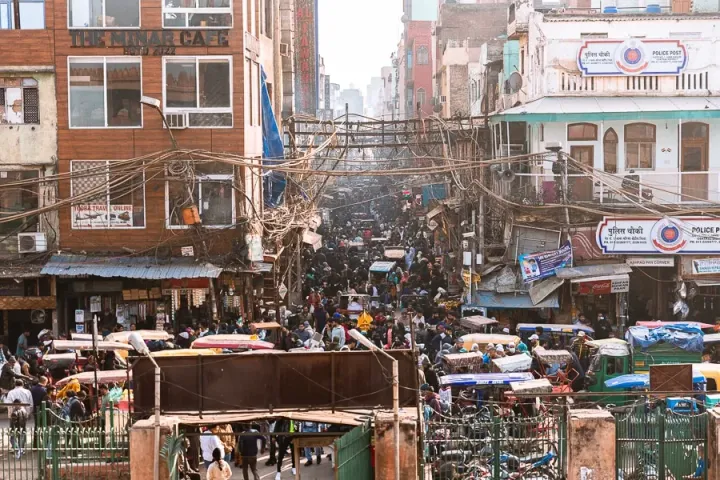Discovering Naughara: A Hidden Gem in Delhi's Bustling Heart
In the pulsating heart of Delhi's Chandni Chowk, a place teeming with life, color, and all imaginable flavors of Indian culture, unfolds a story that begins more than three centuries back. This tale is etched onto the walls and windows of an enchanting alley known as Naughara.
To those who know nothing about it, Naughara might seem like just another name on the map. But delve a little deeper, and you'll find a world where history still lingers in every nook and corner. In this article, you can find a Naughara travel guide that will help you navigate through the historical places in Naughara and Chandni Chowk.
Lost in Time: The Enigmatic Charm of Naughara
Naughara, which translates to "nine houses," is an ancient residential lane that dates back to the 18th century. It is believed to have been established during the Mughal era, a time when Chandni Chowk was the heart of commerce and culture in Delhi. This lane, comprising nine intricately designed havelis (traditional Indian mansions), offers a glimpse into the lifestyle of affluent merchants and artisans of that time.
The origins of Naughara are intertwined with the history of Jain merchants who were instrumental in the economic development of Old Delhi. These merchants were known for their business acumen and their ability to blend seamlessly with the Mughal and local cultures. The establishment of Naughara was not merely about creating a residential space but also about establishing a community that could thrive within the bustling trade center of Chandni Chowk.
A Heritage Treasure
Chandni Chowk, founded in the 17th century by Mughal Emperor Shah Jahan, was once a grand marketplace lined with canals reflecting the moonlight, hence its name, which means "Moonlit Square." Naughara, tucked away in this historical labyrinth, stands as a testament to the era's architectural and cultural opulence. The havelis here were home to Jain merchants who played a significant role in Delhi's trade and economy.
The history of Naughara is closely linked to the rise of Chandni Chowk as a commercial hub. During the Mughal era, Chandni Chowk was designed to be a vibrant market with broad streets, beautiful gardens, and canals. It was a place where traders from different parts of the world would come to sell their goods, making it a melting pot of cultures. Naughara, with its nine havelis, was part of this rich tapestry, contributing to the economic and cultural vibrancy of the area.
The Architectural Marvel of Naughara
Walking into Naughara feels like stepping into a different era. The narrow lane is adorned with beautifully preserved havelis, each showcasing intricate facades, ornate wooden doors, and vibrant frescoes. The architecture is a blend of Mughal and Rajasthani styles, reflecting the cross-cultural influences of the time.
Each haveli in Naughara is unique, yet they share common architectural features that make them stand out. The facades are adorned with floral patterns, geometric designs, and religious motifs, all painted in vibrant colors that have withstood the test of time. The wooden doors are intricately carved with depictions of gods, goddesses, and scenes from Indian mythology, showcasing the craftsmanship of the artisans who built these homes.
The interiors of these havelis, although not typically open to the public, are equally mesmerizing. They feature spacious courtyards, airy balconies, and rooms decorated with traditional furniture and artworks. These homes were designed to be not just living spaces but also centers of social and cultural activities. The courtyards, for instance, were often used for community gatherings, religious ceremonies, and family celebrations.
Naughara Tourism: Colorful Canvasses
For international tourists, Naughara offers a unique window into Delhi's rich history and cultural diversity. Unlike the more crowded and commercial parts of Chandni Chowk, Naughara provides a peaceful and authentic experience. It's a place where you can wander, take photographs, and absorb the historical essence without the usual hustle and bustle.
Naughara's charm lies in its ability to transport visitors back in time. As you walk through the narrow lane, you can almost imagine the bustling activity of the past, with merchants discussing business deals, artisans crafting their wares, and families going about their daily lives. The tranquility of Naughara, combined with its historical significance, makes it a perfect destination for tourists looking to explore a different side of Delhi.
How to Get There: Naughara Travel Guide
Naughara is conveniently located in the heart of Old Delhi, making it easily accessible. Here’s how you can get there:
- By Metro: The nearest metro station is Chandni Chowk (Yellow Line). From there, it's a short rickshaw ride or a leisurely walk through the vibrant streets of Chandni Chowk.
- By Rickshaw: Cycle rickshaws and auto-rickshaws are plentiful in Chandni Chowk. Just ask the rider to take you to Naughara, and they will navigate through the narrow lanes to drop you off at this hidden gem.
- On Foot: If you enjoy walking, you can explore the bustling markets of Chandni Chowk and make your way to Naughara. It’s an adventure in itself!
Chandni Chowk is a sensory overload, with its bustling markets, vibrant street life, and historical landmarks. Walking through the area gives you a chance to soak in the local culture and experience the energy of one of Delhi's most iconic neighborhoods. Naughara, tucked away in a quieter corner, provides a welcome contrast to the surrounding chaos.
Ticket and Entry Information
The beauty of Naughara is that it is a public lane, and there is no entry fee. You can stroll through the lane at your own pace, admire the architecture, and visit the Jain Swetamber Mandir without any cost. However, donations at the temple are always welcome and appreciated.
Since there are no entry restrictions, you can visit Naughara at any time of the day. However, it's best to go during daylight hours to fully appreciate the architectural details and vibrant colors of the havelis. Early mornings or late afternoons are ideal times to visit, as the light is perfect for photography and the area is less crowded.
Naughara and Chandni Chowk: Things To Do
While Naughara itself is a historical site with limited facilities, the surrounding area of Chandni Chowk is well-equipped to cater to tourists:
- Food and Drink: Chandni Chowk is famous for its street food. From spicy chaats to sweet jalebis, there’s something for every palate. There are also several restaurants and cafes where you can enjoy a sit-down meal.
- Shopping: The markets around Naughara are filled with shops selling textiles, jewelry, spices, and handicrafts. It’s a great place to buy unique gifts and souvenirs.
- Restrooms: Public restrooms are available in the larger marketplaces and near major attractions like the Red Fort and Jama Masjid.
- Guides and Tours: If you prefer a guided experience, there are several tour operators offering walking tours of Chandni Chowk, including Naughara. These tours provide historical context and interesting anecdotes that enrich your visit.
Visiting Naughara: Practical Tips for Travelers
To make the most of your visit to Naughara and Chandni Chowk, here are some practical tips:
- Dress Comfortably: Wear comfortable shoes and light clothing, as you’ll be doing a lot of walking. Keep a scarf or shawl handy for visiting temples.
- Stay Hydrated: Delhi can get quite hot, especially in the summer. Carry a bottle of water to stay hydrated.
- Be Respectful: Naughara is a residential area, so be mindful of the residents and their privacy. Avoid loud conversations and be respectful when taking photographs.
- Stay Safe: Chandni Chowk is a crowded area, so keep your belongings secure and be aware of your surroundings. Pickpocketing can be an issue in crowded places.
- Explore Early: If you prefer a quieter experience, visit early in the morning when the streets are less crowded.
- Cash is King: While many shops accept credit cards, it’s a good idea to carry some cash for small purchases and street food.
Naughara Tourism: Key Attractions Nearby
While Naughara is a captivating destination on its own, there are several nearby attractions that you shouldn’t miss:
- The Jain Svetambar Temple: At the end of this mesmerizing vibrant alley stands a stark contrast — a white marble sanctuary that emanates tranquillity amidst all the colour. This is the Jain Svetambar Temple, an oasis of serenity in Naughara.Built during the 19th century, this temple is not just a spiritual abode but also a testament to exquisite craftsmanship. It is adorned with intricate carvings and bright murals that lend it an ethereal touch. With its grandeur and calmness, it offers a refuge for those seeking solitude in a city that never sleeps.
- Red Fort: A UNESCO World Heritage Site, the Red Fort is a magnificent example of Mughal architecture and a symbol of India’s rich history. Built by Emperor Shah Jahan in the mid-17th century, this sprawling fort complex features impressive red sandstone walls, intricate carvings, and beautiful gardens. The fort hosts a light and sound show in the evenings, which narrates the history of Delhi in an engaging manner.
- Jama Masjid: One of the largest mosques in India, Jama Masjid is an architectural marvel and offers a panoramic view of Delhi from its minarets. Built by Shah Jahan, the mosque features grand domes, towering minarets, and a vast courtyard that can accommodate thousands of worshippers. Climbing the southern minaret is a must for a breathtaking view of Old Delhi.
- Paranthe Wali Gali: For food lovers, this famous lane offers a variety of stuffed parathas (Indian flatbread) that are a culinary delight. Each shop in this lane has its unique take on parathas, with fillings ranging from traditional potatoes and paneer to exotic ingredients like rabri and banana. It's a perfect spot for a delicious and hearty meal.
- Chandni Chowk Market: From jewelry to spices, this bustling market is a shopper’s paradise. It’s a great place to pick up souvenirs and experience the vibrant local culture. The market is divided into several lanes, each specializing in different goods, such as textiles, electronics, and street food. Bargaining is a common practice here, so be prepared to negotiate for the best prices.
- Gurudwara Sis Ganj Sahib: A significant Sikh shrine, Gurudwara Sis Ganj Sahib marks the site where the ninth Sikh Guru, Guru Tegh Bahadur, was martyred. The gurudwara is a place of worship and community service, offering free meals to all visitors in its langar (community kitchen). The serene atmosphere and spiritual significance make it a worthwhile visit.
- Khari Baoli: Asia’s largest spice market, Khari Baoli is a sensory overload with its vibrant colors and strong aromas. Here, you can find a wide variety of spices, dried fruits, nuts, and herbs. It's a fantastic place to learn about Indian spices and pick up some authentic ingredients for your kitchen.
Get Set to Experience One of Delhi's Historical Places
Naughara, a lane of nine houses in the heart of Delhi's Chandni Chowk, is no ordinary locale. It's an open museum that showcases centuries-old architecture, vibrant culture, and intriguing tales from the past. Each haveli, with its vibrant door and unique architecture, stands as a testament to the rich cultural heritage of India. As you walk down this serene alley amidst the bustling city life, you can't help but feel like you've taken a stroll through history.
Despite its historical significance and aesthetic appeal, Naughara remains relatively unknown to many. But if you're someone who appreciates beauty in simplicity and finds joy in uncovering lesser-known tales of our past, then Naughara is undoubtedly a must-visit spot on your Naughara travel guide.
There's so much more to explore and learn about this fascinating place. So, are you ready to dive deeper into the enchanting world of Naughara and unravel its hidden tales? Every door in this charming lane opens up to a new story waiting to be discovered!




Comments ()